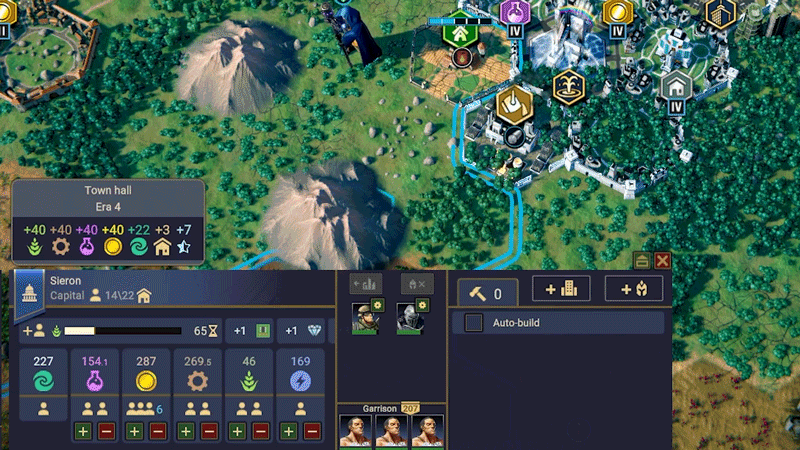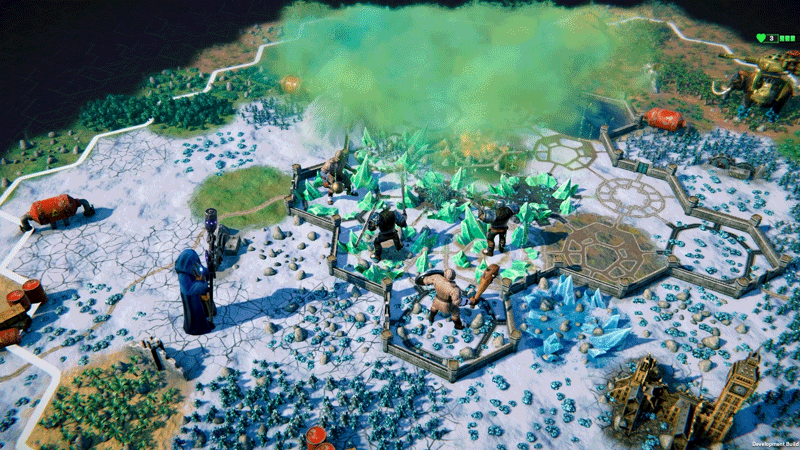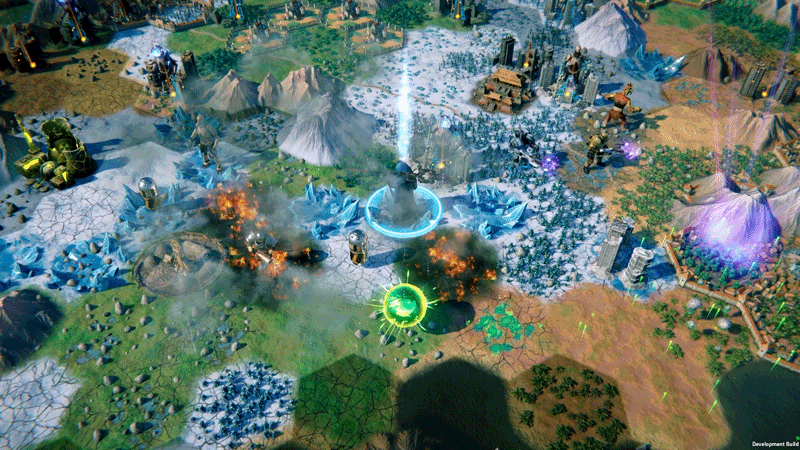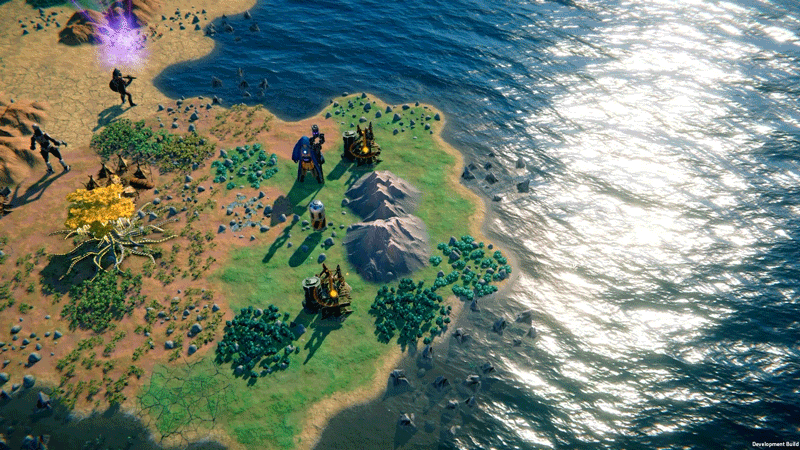The First Revival: Recolonization Patch
Greetings!
We want to thank all the players who have joined the Revival: Recolonization community. Your game impressions and feedback help us to find the game’s weak spots, improve gameplay and mechanics, and fix bugs.
Here’s a patch that fixes several issues and enhances gameplay.
What's new:
1. The AI turn waiting time has been reduced by 40% in the early and mid-game phases. We plan to continue improving this aspect.
2. You can now build as many Nexuses as you want. As Emperor Palpatine said, "UNLIMITED POWER!!!"

3. Before the battle starts, the support squad's status is displayed in the accompanying window. If a squad has already participated in a battle in that turn, it will be displayed as inactive. So you can assess your available resources before the battle begins.

4. We made the interaction with the Worker unit more understandable. The game interface did not clearly show the difference between inactive and active buildings that the unit can build when studying related science and having strategic resources on the hex with the Worker. Now, if the unit is on a hex where it cannot build a certain object, the corresponding buttons appear inactive. When you hover over them, a tooltip appears with an explanation.
5. Now, after the Emissaries' recovery, their health is fully restored. The statuses received before death in battle are removed.
6. City districts are now built at the same level as the town hall (the city's central building). If your town hall is from the third era, all new city districts will be built at the third era level.
7. Shields do not prevent the owner of the region from using edicts anymore.

The patch also makes some changes to the combat system. Specifically:
1. Archers can now retreat from enemies, without triggering the control zone.
2. We increased the priority of the "Shield Bash" AI attack if it pushes a unit into the sea. However, "Shield Bash" no longer affects artillery and mobile troops (too heavy).
3. We fixed a bug where ranged units received the "Electrified" status after being attacked by a unit with the "GMO: Shock Feedback".
4. We made changes to the battle interface. Now, units that have already taken their turn in combat appear less noticeably on the menu panel than units that the player has not yet used.
5. We fixed a bug where a unit with the "Frozen" status could attack and move under the influence of the "Mind Control" edict.
6. Hotkeys are now available in combat. You can see them on the game’s settings screen.
7. The turn automatically passes from the Emissary to another unit in battle only if the Emissary launches an edict.
8. We limited the camera's distancing in a battle for a more optimal gaming experience.

Based on your feedback, we made changes to the game interface:
1. We increased the tooltip display speed. For example, popup windows with hex climate type.
2. Now, when you hover over a unit on the global map, the unit's description group window is always displayed.
3. We updated the composition of the anomaly descriptions in their tooltip (a popup window that appears when hovering over it). Now, you can see immediately what effects the anomaly has on nearby hexes or regions.
4. We updated the composition of edict descriptions - the impact on enemy squads in battle is now listed first.
5. We fixed different icon sizes in science tooltips.
6. We fixed the lack of changes when scaling the interface if applied in the main menu after a match.
We also fixed other minor bugs and issues, including:
1. Inaccessibility of the city after building the Cathedral of Reconciliation.
2. Inability to join a city from the Free Towns faction while having sufficient resources.
3. Incorrect counting of the number of grown forests and bushes. Now, fires and high-to-low growth conversion do not affect it.
4. The absence of a number on the resource exchange screen for "Edicts" and "Science" resources.
5. The absence of a lock on the contract duration (increasing or decreasing) button when reaching the limit.
6. The possibility to change the term in the contract offered by AI.
7. An issue when the construction queue in the city panel was not updated after destroying a district.
8. Opening the edict screen by hotkey “C”, even if the unit has no moves left.
9. The empire plans launching screen not closing after some other screens appears.
10. We removed extraneous sounds in the tutorial intro video.
11. We fixed incorrect music playback in the tutorial.
Thanks a lot for supporting us in our 4X strategy game development path.
Join our Discord and share your feedback on the game.
Best regards,
The Revival: Recolonization team.
We want to thank all the players who have joined the Revival: Recolonization community. Your game impressions and feedback help us to find the game’s weak spots, improve gameplay and mechanics, and fix bugs.
Here’s a patch that fixes several issues and enhances gameplay.
What's new:
1. The AI turn waiting time has been reduced by 40% in the early and mid-game phases. We plan to continue improving this aspect.
2. You can now build as many Nexuses as you want. As Emperor Palpatine said, "UNLIMITED POWER!!!"

3. Before the battle starts, the support squad's status is displayed in the accompanying window. If a squad has already participated in a battle in that turn, it will be displayed as inactive. So you can assess your available resources before the battle begins.

4. We made the interaction with the Worker unit more understandable. The game interface did not clearly show the difference between inactive and active buildings that the unit can build when studying related science and having strategic resources on the hex with the Worker. Now, if the unit is on a hex where it cannot build a certain object, the corresponding buttons appear inactive. When you hover over them, a tooltip appears with an explanation.
5. Now, after the Emissaries' recovery, their health is fully restored. The statuses received before death in battle are removed.
6. City districts are now built at the same level as the town hall (the city's central building). If your town hall is from the third era, all new city districts will be built at the third era level.
7. Shields do not prevent the owner of the region from using edicts anymore.

The patch also makes some changes to the combat system. Specifically:
1. Archers can now retreat from enemies, without triggering the control zone.
2. We increased the priority of the "Shield Bash" AI attack if it pushes a unit into the sea. However, "Shield Bash" no longer affects artillery and mobile troops (too heavy).
3. We fixed a bug where ranged units received the "Electrified" status after being attacked by a unit with the "GMO: Shock Feedback".
4. We made changes to the battle interface. Now, units that have already taken their turn in combat appear less noticeably on the menu panel than units that the player has not yet used.
5. We fixed a bug where a unit with the "Frozen" status could attack and move under the influence of the "Mind Control" edict.
6. Hotkeys are now available in combat. You can see them on the game’s settings screen.
7. The turn automatically passes from the Emissary to another unit in battle only if the Emissary launches an edict.
8. We limited the camera's distancing in a battle for a more optimal gaming experience.

Based on your feedback, we made changes to the game interface:
1. We increased the tooltip display speed. For example, popup windows with hex climate type.
2. Now, when you hover over a unit on the global map, the unit's description group window is always displayed.
3. We updated the composition of the anomaly descriptions in their tooltip (a popup window that appears when hovering over it). Now, you can see immediately what effects the anomaly has on nearby hexes or regions.
4. We updated the composition of edict descriptions - the impact on enemy squads in battle is now listed first.
5. We fixed different icon sizes in science tooltips.
6. We fixed the lack of changes when scaling the interface if applied in the main menu after a match.
We also fixed other minor bugs and issues, including:
1. Inaccessibility of the city after building the Cathedral of Reconciliation.
2. Inability to join a city from the Free Towns faction while having sufficient resources.
3. Incorrect counting of the number of grown forests and bushes. Now, fires and high-to-low growth conversion do not affect it.
4. The absence of a number on the resource exchange screen for "Edicts" and "Science" resources.
5. The absence of a lock on the contract duration (increasing or decreasing) button when reaching the limit.
6. The possibility to change the term in the contract offered by AI.
7. An issue when the construction queue in the city panel was not updated after destroying a district.
8. Opening the edict screen by hotkey “C”, even if the unit has no moves left.
9. The empire plans launching screen not closing after some other screens appears.
10. We removed extraneous sounds in the tutorial intro video.
11. We fixed incorrect music playback in the tutorial.
Thanks a lot for supporting us in our 4X strategy game development path.
Join our Discord and share your feedback on the game.
Best regards,
The Revival: Recolonization team.






















